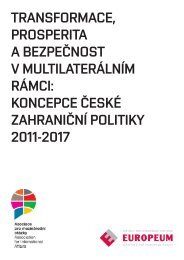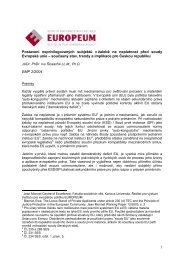eu constitutionalisation - EUROPEUM Institute for European Policy
eu constitutionalisation - EUROPEUM Institute for European Policy
eu constitutionalisation - EUROPEUM Institute for European Policy
Create successful ePaper yourself
Turn your PDF publications into a flip-book with our unique Google optimized e-Paper software.
Chapter 1: Constitutionalisation: the Case of the Convention as a Network Analysisg The Charter of Fundamental Rights and its placement in the Treaties(Antonio Vitorino, EC), CONV 354/02, 22 October 2002g Legal personality of the EU (Giuliano d'Amato, Vice-President of theConvention), CONV 305/02, 1 October 2002g The role of national parliaments (Gisela Stuart, national parliament – UK),CONV 353/02, 22 October 2002g The supplementary competencies of the EU (Henning Christophersen, governmentrepresentative, Denmark), CONV 375/1/02, 4 November 2002g Economic and Financial Cooperation (Klaus Hänsch, EP), CONV357/02, 21 October 2002The working groups presented the results of their work during the autumn2002. Later on, several new groups were created to discuss in particular:g Justice and home affairs and the <strong>for</strong>mer “Third pillar” (John Bruton,national parliament – Ireland), CONV 426/02, 2 December 2002g External Affairs of the EU (Jean-Luc Dehaene, Vice-President of theConvention), CONV 459/02, 16 December 2002g Defence <strong>Policy</strong> (Michel Barnier, EC), CONV 461/02, 16 December 2002g Simplification of laws and procedures, Giuliano d’Amato, CONV 424/02,29 November 2002.⁵⁰After a heated discussion one more group, dealing with the so-called SocialEurope was set up. It was chaired by George Kati<strong>for</strong>is, representative of theGreek government, and its final report was presented on 4 February 2003(CONV 516/1/03).⁵¹ A “skeleton” draft of the Constitution was introducedby Giscard on 28 October 2002⁵². “Flesh” was added, step by step, articleby article, during the first half of 2003. The third phase of the Conventionstarted, the <strong>constitutionalisation</strong> of Europe was on the agenda.Parallel to the Convention, another <strong>for</strong>um was created to serve as plat<strong>for</strong>m<strong>for</strong> discussion and participation of citizens, NGOs, civil society, think-tanks,academics, trade unions etc. The Convention of Youth and national conventionsin every member state and candidate state were also discussingquestions concerning the future of Europe. All contributions were made50) Ibid.51) NORMAN (2003), p. 61-6252) <strong>European</strong> Convention, Preliminary Draft Constitutional Treaty36Chapter 1: Constitutionalisation: the Case of the Convention as a Network Analysisavailable to the public via the Convention web page.⁵³ Thus we can arguethat the method of the Convention, characterized by its relative opennessand transparency, tried to bring the EU closer to the citizens.After 16 months of heated and frequently emotional debates between themembers of the Convention and also bearing in mind contributions fromnon-governmental organizations and general public, the Convention cameto a result: one text, a draft of a <strong>European</strong> Constitution.⁵⁴ Its first part,introduced by a Preamble stressing the “unity in diversity”, was devoted tothe definition of the Union and its objectives, to the relations between theUnion and the member states, to fundamental rights and citizenship. TheEU as a whole was given legal personality. Articles dealing with the divisionof competencies established three categories of powers: exclusive EUcompetencies, shared competencies and areas where EU institutions couldonly support the work of the member states with complementary action.The re<strong>for</strong>m of EU institutions proved out to be the most contentious partof the final deal, especially among the government representatives. Someof the most controversial points were the creation of a permanent Chair ofthe <strong>European</strong> Council and the appointment and number of the college ofCommissioners. Another highly sensitive issue was the question of qualifiedmajority voting (QMV). Instead of the current system, where votesare allocated according to a complicated weighting procedure, a moresimple “double majority rule” was proposed. This would entail 50 per centof member states, representing 60 per cent of the EU population.⁵⁵ A newposition, the Union Minister <strong>for</strong> Foreign Affairs was created (<strong>for</strong> his remit,see other contributions in this volume). The legislative procedure was alsosimplified. Articles dealing with Union membership clarified the terms ofaccession, suspension procedures and <strong>for</strong> the first time allowed <strong>for</strong> memberstate to withdraw from the Union.⁵⁶Part II of the text incorporated the Charter of Fundamental Rights, whichhad already been accepted as a political document at the Nice summit in2000. Part III was discussed during the last two sessions of the Convention53) http://<strong>eu</strong>ropean-convention.<strong>eu</strong>.int/54) <strong>European</strong> Convention, Draft Treaty Establishing a Constitution <strong>for</strong> Europe55) This is when especially Ms. Anna Palacio, minister of <strong>for</strong>eign affairs of Spain and Ms. Danuta Huebner,minister <strong>for</strong> Europe of Poland, both government representatives, protested.56) <strong>European</strong> Convention, Draft Treaty Establishing a Constitution <strong>for</strong> Europe37








